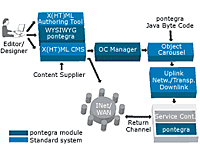 America Online has announced a consumer VoIP application, Wanadoo joins the party. The AOL offering will go head-to-head with traditional telephone companies, cable firms and a multitude of start-ups competing for the mainstream-bound VoIP market.
America Online has announced a consumer VoIP application, Wanadoo joins the party. The AOL offering will go head-to-head with traditional telephone companies, cable firms and a multitude of start-ups competing for the mainstream-bound VoIP market.
AOL CEO Jonathan Miller announced the decision at VON Spring 2005 trade show, “Within the next month, AOL will launch an Internet phone product, and we believe it will be a truly differentiated product. The initial launch targets specific markets and AOL users.”
Miller added, “Consumers just want something that is reliable and easy to use. Over 60 percent of consumers don’t know what VoIP is or don’t understand what it is, but it is possible they could be sold on it.”
“AOL aims to closely integrate the VoIP service with AOL’s popular email and IM service to create a sort of “communications dashboard. “It will become the centrepiece of the way consumers handle their communications online”, beamed Miller.
The company’s customers will continue to use their traditional phones, but will plug them into adapters connected to their broadband source rather than the socket provided by the telephone company.
 The AOL product will also allow customers to turn IM sessions into phone calls when one of the parties enters the phrase “Can I Call?”
The AOL product will also allow customers to turn IM sessions into phone calls when one of the parties enters the phrase “Can I Call?”
At this point the AOL product will “almost instantaneously” switch the communications session to a VOIP call if the user on the other end is “present.”
To provide the VoIP service, AOL are teaming up with Level 3 Communications who will provide the infrastructure needed to comply with federal 911 and number portability requirements and Sonus Networks who will be responsible for the softswitching.
The company is yet to divulge pricing details for its US service or timetable roll outs in international markets.
Wanadoo
Meanwhile, the stampede for ISPs to reinvent themselves as telcos continues with the French Telecom-owned Wanadoo announcing a new voice over broadband service last week.
For £4 a month, Wanadoo’s broadband customers can get a slice of the free phone call action to other UK landlines during evenings and weekends.
The ISP maintains that the cost of other calls made using its “Wanadoo Wireless and Talk” service are cheaper than BT, while calls to other “Wanadoo Wireless and Talk” punters will cost customers jack diddly squat.
The new service uses Wanadoo’s “Livebox” wireless box to route calls over broadband. Wanadoo’s broadband telephony service is designed as a secondary phone line service for now, but the ISP is hatching cunning plans for it to replace a household’s primary phone line.
Wanadoo UK’s chief exec, Eric Abensur, was on hand to give it the big one, boasting that his company was at the “cutting edge of this fantastic technology”.
He went on to say, “As broadband becomes a standard feature in UK homes – like turning on a tap it will become second nature to use it for all types of services – such as plugging a phone or two into your home network or watching TV, and we look forward to making further exciting announcements over the coming months.”
Wanadoo’s VoIP service launched in France last year, but was riddled with so many bugs that almost 300 Wanadoo staff in France went on strike before Christmas in protest at having to deal with extra-stroppy customers complaining that the service didn’t work.
However, a spokeswoman for Wanadoo UK said that call centre staff in the UK had been fully trained to support the product. “We’d only launch a product that we have confidence in,” she said.
AOL
Wanadoo
 European telco AB has announced that it’s launched the first worldwide free TV station available on 3G mobile phones, via its own TV channel Tango.TV (TTV).
European telco AB has announced that it’s launched the first worldwide free TV station available on 3G mobile phones, via its own TV channel Tango.TV (TTV).![]() We couldn’t work out if this was supposed to be the 3G TV station or not, but after five minutes of looking at a blank screen on our desktop media player, we gave up waiting.
We couldn’t work out if this was supposed to be the 3G TV station or not, but after five minutes of looking at a blank screen on our desktop media player, we gave up waiting. The wires are buzzing with rumours that Barry Diller’s InterActive Corp (IAC) is set to buy the Internet search engine service Ask Jeeves for almost $2bn.
The wires are buzzing with rumours that Barry Diller’s InterActive Corp (IAC) is set to buy the Internet search engine service Ask Jeeves for almost $2bn. We tried to check the story by visiting Ask Jeeves and typing in, “are you being bought by InterActive Corp?”
We tried to check the story by visiting Ask Jeeves and typing in, “are you being bought by InterActive Corp?” Until now, Apple has been pretty safe in its position of master of all digital music players. That’s lead to speculation of their crown slipping. We’re fresh back from the European consumer show CeBIT and saw many, many good looking, highly functioned, portable music players there.
Until now, Apple has been pretty safe in its position of master of all digital music players. That’s lead to speculation of their crown slipping. We’re fresh back from the European consumer show CeBIT and saw many, many good looking, highly functioned, portable music players there. With a lucrative mobile market hungry for content, it’s not surprising to find a host of companies getting their thinking caps on.
With a lucrative mobile market hungry for content, it’s not surprising to find a host of companies getting their thinking caps on. In addition, the winner and two runner-ups each received filmmaking training courses courtesy of Raindance.
In addition, the winner and two runner-ups each received filmmaking training courses courtesy of Raindance. Internet giants Yahoo are preparing to introduce a new service that blends several of the popular features of its site with two of the Web’s fastest growing activities – blogging and social networking.
Internet giants Yahoo are preparing to introduce a new service that blends several of the popular features of its site with two of the Web’s fastest growing activities – blogging and social networking. Thrill-seeking mobile phone users around the world slapped out US$400 million on pornographic pictures and video in 2004 – an amount that is expected to rise to US$5 billion by 2010, according to a report by research group Strategy Analytics.
Thrill-seeking mobile phone users around the world slapped out US$400 million on pornographic pictures and video in 2004 – an amount that is expected to rise to US$5 billion by 2010, according to a report by research group Strategy Analytics. The US$5 billion forecast for 2010 represents a huge upward shift from Strategy Analytics’ earlier predictions, with the company noting that adult entertainment businesses are aggressively building services and customers appear happy to shell out for them.
The US$5 billion forecast for 2010 represents a huge upward shift from Strategy Analytics’ earlier predictions, with the company noting that adult entertainment businesses are aggressively building services and customers appear happy to shell out for them. MP3 playing device includes software for sending and receiving Internet-based phone calls.
MP3 playing device includes software for sending and receiving Internet-based phone calls. Ezmax demonstrated the device at their stand at CeBIT, plugging the player into a notebook PC and successfully making a call via the VoIP dialling software.
Ezmax demonstrated the device at their stand at CeBIT, plugging the player into a notebook PC and successfully making a call via the VoIP dialling software. In addition, the device is capable of voice recording and sports a two-colour (blue and yellow) 128 pixel by 64 pixel OLED screen.
In addition, the device is capable of voice recording and sports a two-colour (blue and yellow) 128 pixel by 64 pixel OLED screen. Shipments of MP3 players soared by an enormous 116% in 2004, as hundreds of wallet-tempting products arrived in response to the phenomenal success of Apple iPod player, according to a survey by Market Intelligence firm, iSuppli.
Shipments of MP3 players soared by an enormous 116% in 2004, as hundreds of wallet-tempting products arrived in response to the phenomenal success of Apple iPod player, according to a survey by Market Intelligence firm, iSuppli. The iSuppli report also predicts that HDD-based MP3 player shipments will grow by a CAGR of 41.8% from 2004 to 2009, as compared to 22.9% for flash-based players.
The iSuppli report also predicts that HDD-based MP3 player shipments will grow by a CAGR of 41.8% from 2004 to 2009, as compared to 22.9% for flash-based players. America Online has announced a consumer VoIP application, Wanadoo joins the party. The AOL offering will go head-to-head with traditional telephone companies, cable firms and a multitude of start-ups competing for the mainstream-bound VoIP market.
America Online has announced a consumer VoIP application, Wanadoo joins the party. The AOL offering will go head-to-head with traditional telephone companies, cable firms and a multitude of start-ups competing for the mainstream-bound VoIP market. The AOL product will also allow customers to turn IM sessions into phone calls when one of the parties enters the phrase “Can I Call?”
The AOL product will also allow customers to turn IM sessions into phone calls when one of the parties enters the phrase “Can I Call?” MTV in Germany has been demonstrating an interactive TV portal that combines satellite and broadband services.
MTV in Germany has been demonstrating an interactive TV portal that combines satellite and broadband services. MTV is using Alticast for the technical implementation and broadcast of the interactive service.
MTV is using Alticast for the technical implementation and broadcast of the interactive service.